Overview
The primary objective of this article is to present a structured methodology for booking a demo of digital land record software, articulated through five essential steps:
- Assessing needs
- Researching options
- Contacting vendors
- Preparing questions
- Evaluating the demo
By following these steps, users can ensure they are well-informed and ready to make a decisive and effective choice.
Introduction
Navigating the realm of digital land record software presents a formidable challenge, particularly given the extensive range of options available today. Organizations are increasingly acknowledging the critical need for efficient property record management; however, many encounter difficulties in pinpointing their specific requirements and selecting the appropriate solution. This guide delineates five essential steps to effectively book a demo, equipping decision-makers with the tools necessary to evaluate the software that aligns best with their operational needs.
How can one strategically leverage these demos to assess functionality while ensuring alignment with long-term organizational goals?
Identify Your Digital Land Record Software Needs
Begin by assessing your current property record management procedures to identify specific challenges. Consider the following factors:
- Volume of Records: Evaluate the total number of records under your management. Title researchers frequently handle extensive quantities, with some organizations overseeing hundreds of thousands of documents.
- Types of Records: Identify the various types of land records you encounter, such as deeds, leases, and surveys. Understanding the diversity of records is crucial for selecting appropriate applications.
- Integration Requirements: Determine whether the new application must connect with your existing systems. Seamless integration can significantly enhance operational efficiency and mitigate disruptions.
- User Requirements: Clarify who will utilize the application and their specific needs. Engaging with end-users can uncover essential insights into functionality and usability that may otherwise be overlooked.
Recording these needs will provide a comprehensive overview of your requirements, guiding you toward the most suitable digital record management solution. As Karla Gilbride, General Counsel of the EEOC, stated, "Effective supervision of documents is not merely a regulatory obligation; it is a cornerstone of operational integrity and efficiency." This underscores the importance of thorough evaluations in ensuring effective record management.
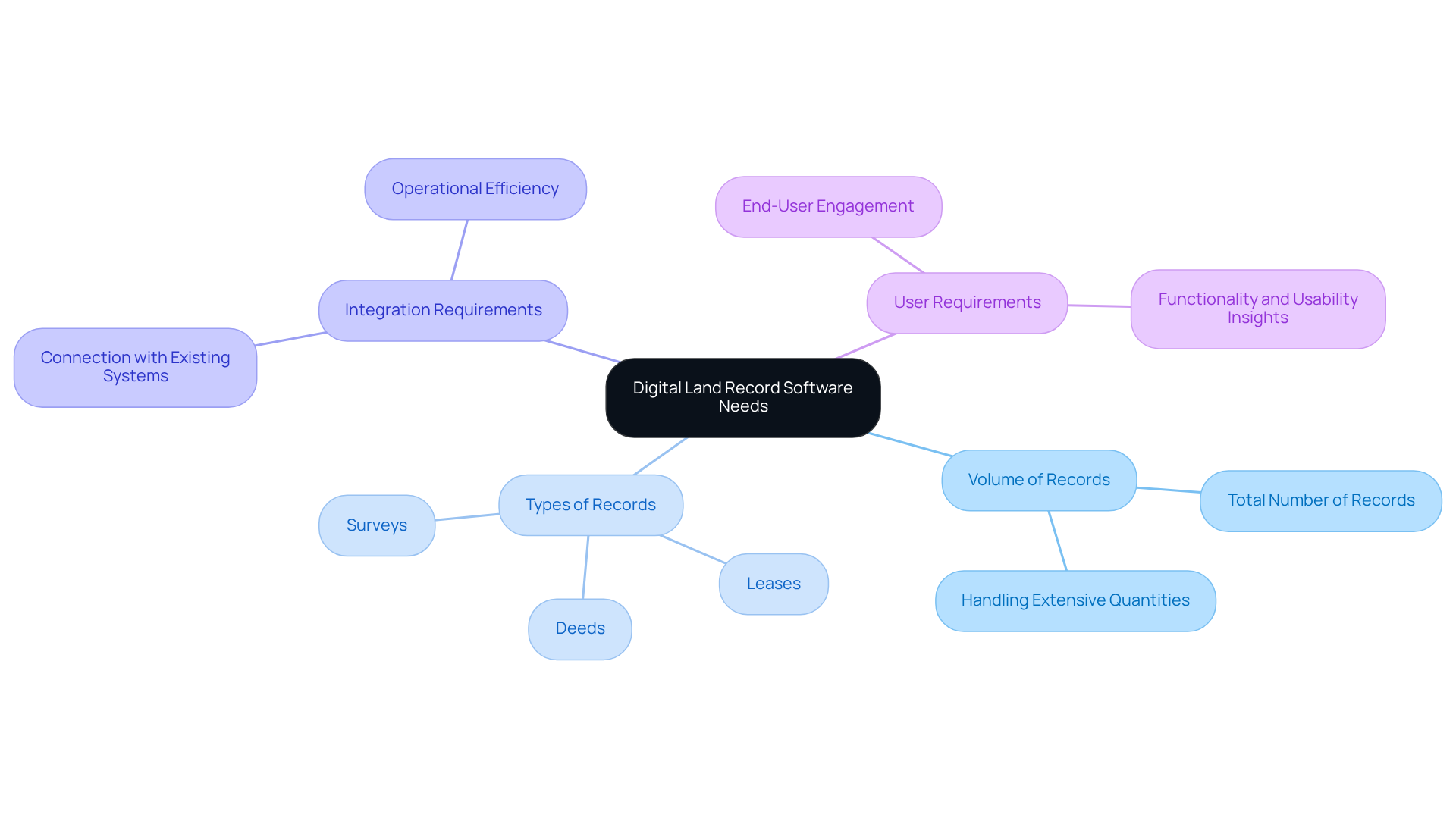
Research Available Digital Land Record Software Options
To effectively research available digital land record software options, it is essential to consider several methods:
- Online Reviews: Utilize platforms such as Capterra or G2 to explore user reviews and ratings. These insights can provide a clear view of application performance and user satisfaction.
- Vendor Websites: Visit the websites of potential vendors to gather detailed information on features, pricing structures, and customer support options. This will enable you to assess which solutions best meet your requirements.
- Industry Forums: Engage in conversations on forums or social media groups focused on land management applications. Interacting with industry peers can yield valuable insights and recommendations.
- Peer Recommendations: Reach out to colleagues or industry contacts to inquire about their experiences with particular applications. Firsthand accounts can guide you toward reliable options.
Incorporating insights from case studies, such as the significance of automated data validation in enhancing data governance and reliability, provides practical examples of how technology can improve decision-making processes. Furthermore, consider remarks from industry pioneers such as John D. Rockefeller, who observed that "the major fortunes in America have been made in real estate," underscoring the importance of comprehensive research in selecting property management tools.
Create a list of three to five software options that align with your specific requirements, ensuring to take into account current trends in digital record software features, such as automated data validation and user-friendly interfaces, to enhance your decision-making process. For instance, RealEstateAPI offers access to financial and physical details of 159 million properties, highlighting the scale and importance of accurate data in land management.
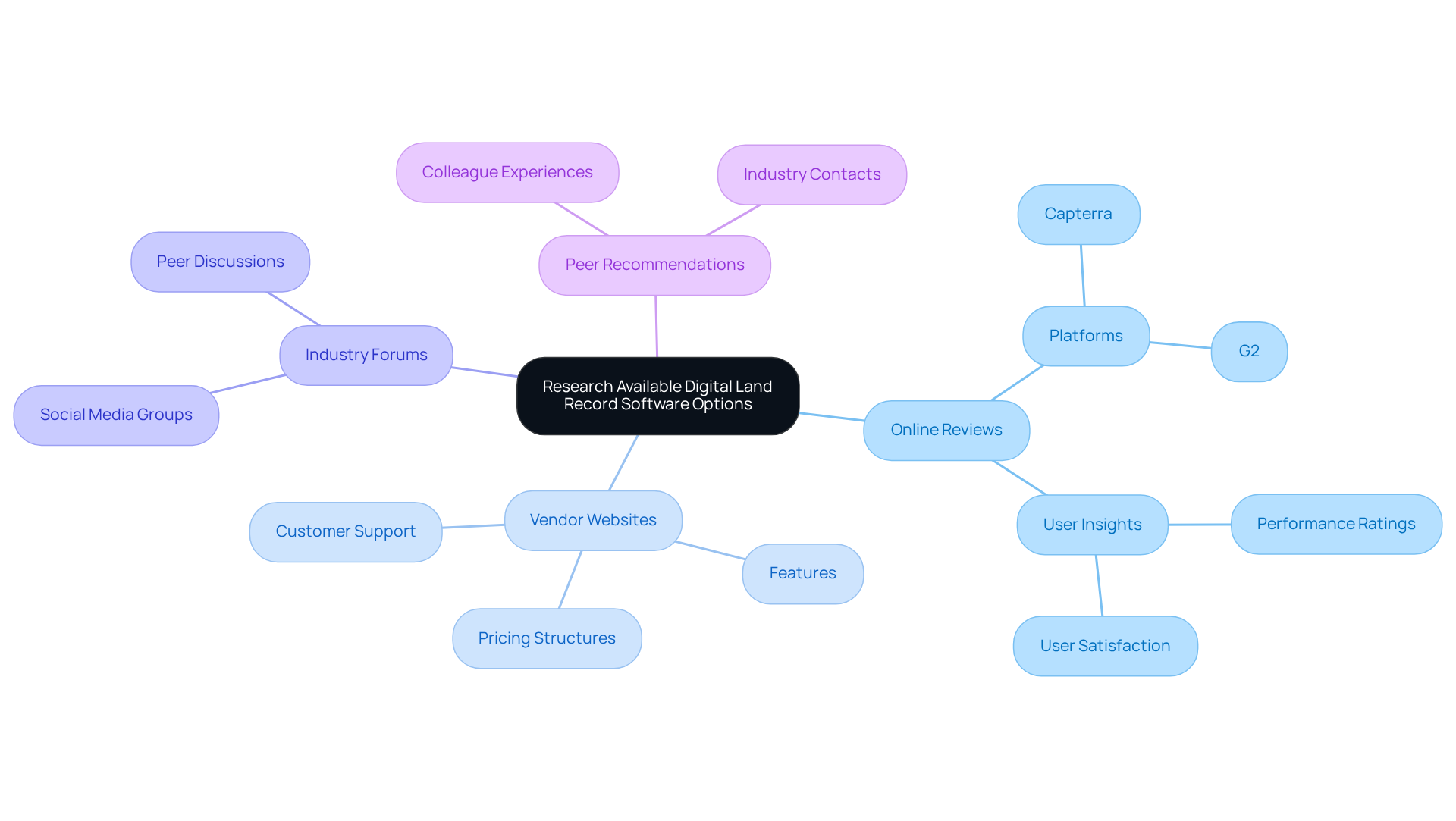
Contact Vendors to Schedule Your Demo
Once you have your shortlist, it is essential to contact the vendors to arrange presentations. Follow these steps to ensure a smooth process:
- Prepare Your Inquiry: Clearly articulate your interest in a demo, specifying your unique needs and expectations. This sets the stage for a productive conversation.
- Choose a Suitable Time: Propose several time slots that accommodate both your schedule and the vendor's availability. This flexibility can facilitate quicker responses.
- Ask About the Presentation Format: Inquire whether the presentation will be live, recorded, or self-guided. Understanding the format helps you prepare accordingly and ensures that all stakeholders can engage effectively.
- Confirm Attendees: Ensure that all relevant stakeholders from your team will be present during the presentation. Having a diverse group can lead to more comprehensive discussions and better decision-making.
- Inquire About Training Provisions: Ask the vendor about the training they provide for users and system administrators, as this is crucial for effective implementation.
Sending a formal email or utilizing the vendor's contact form to initiate the scheduling process is recommended. Remember, replying quickly to trial requests is essential; businesses that interact with leads within the first five minutes are 21 times more likely to turn them into sales opportunities. By following these steps, you can significantly enhance your chances of a successful presentation experience, especially if you book a demo for digital land record software.
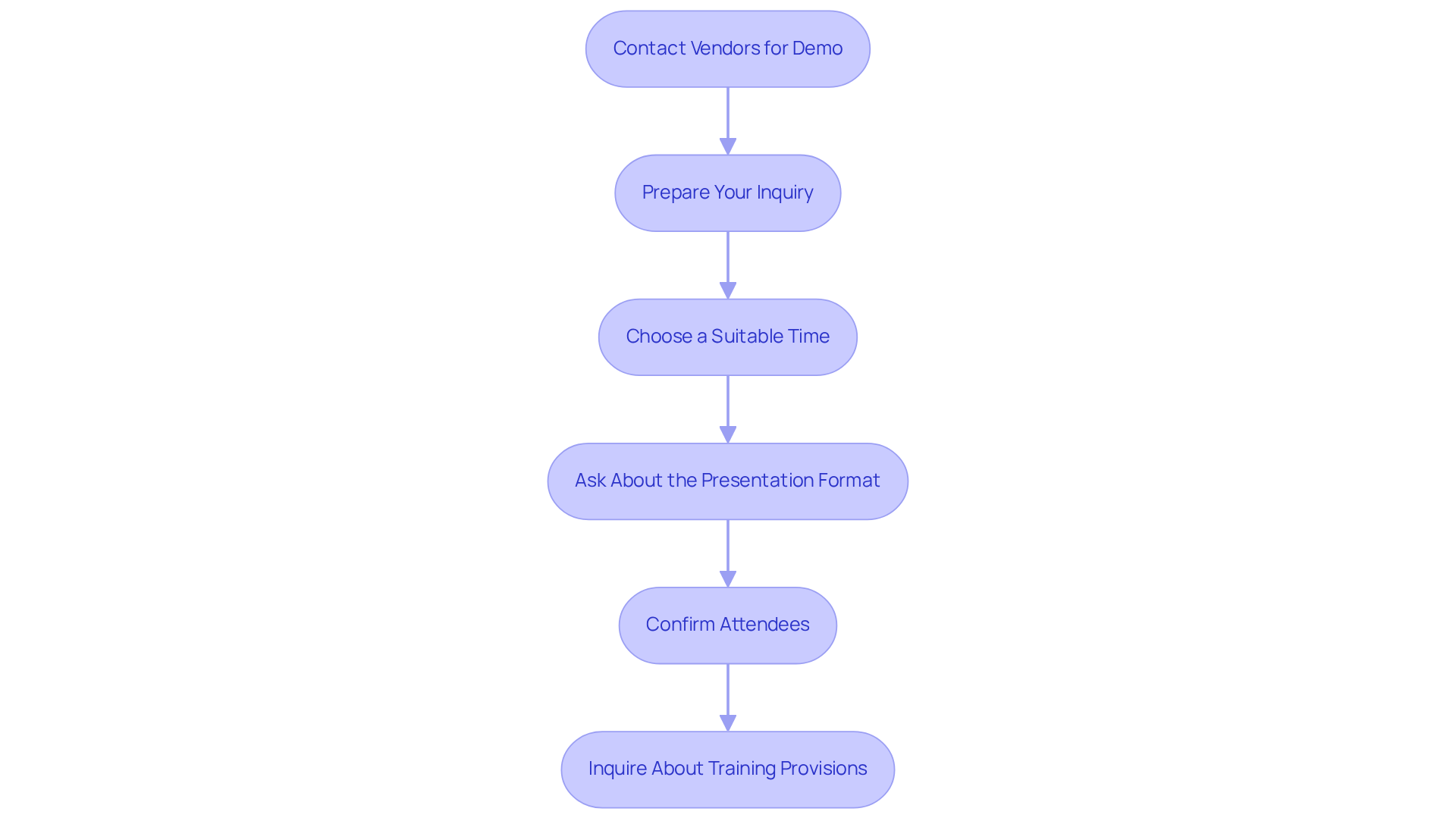
Prepare Questions and Objectives for the Demo
It is essential to prepare a comprehensive list of questions and objectives before you book a demo for digital land record software to maximize this opportunity. Consider the following key areas:
- Functionality: Inquire about how the software addresses specific tasks pertinent to your operations. Understanding its capabilities will help you assess its fit for your needs.
- User Experience: Assess the interface and intuitiveness of the application. A positive experience for customers is essential; research indicates that 88% of individuals are less likely to return after a negative interaction, and 90% of smartphone owners report they are more inclined to continue shopping if they enjoy an excellent experience. Aim to determine how easily your team can navigate the system.
- Integration: Inquire if the application can seamlessly connect with your current systems. This is vital for maintaining workflow efficiency and minimizing disruption.
- Support and Training: Clarify the type of support and training the vendor provides. Effective onboarding can significantly enhance user satisfaction and adoption rates.
- Cost Structure: Understand the pricing models and inquire about any potential hidden fees. Transparency in costs is essential for budgeting and financial planning.
Establish clear goals for the presentation, such as determining how the application can enhance your workflows and boost overall efficiency, to encourage attendees to book a demo for digital land record software. As noted, a well-executed UX design can triple website conversion rates; therefore, concentrate on how the application aligns with your organizational goals and enhances your title research operations.
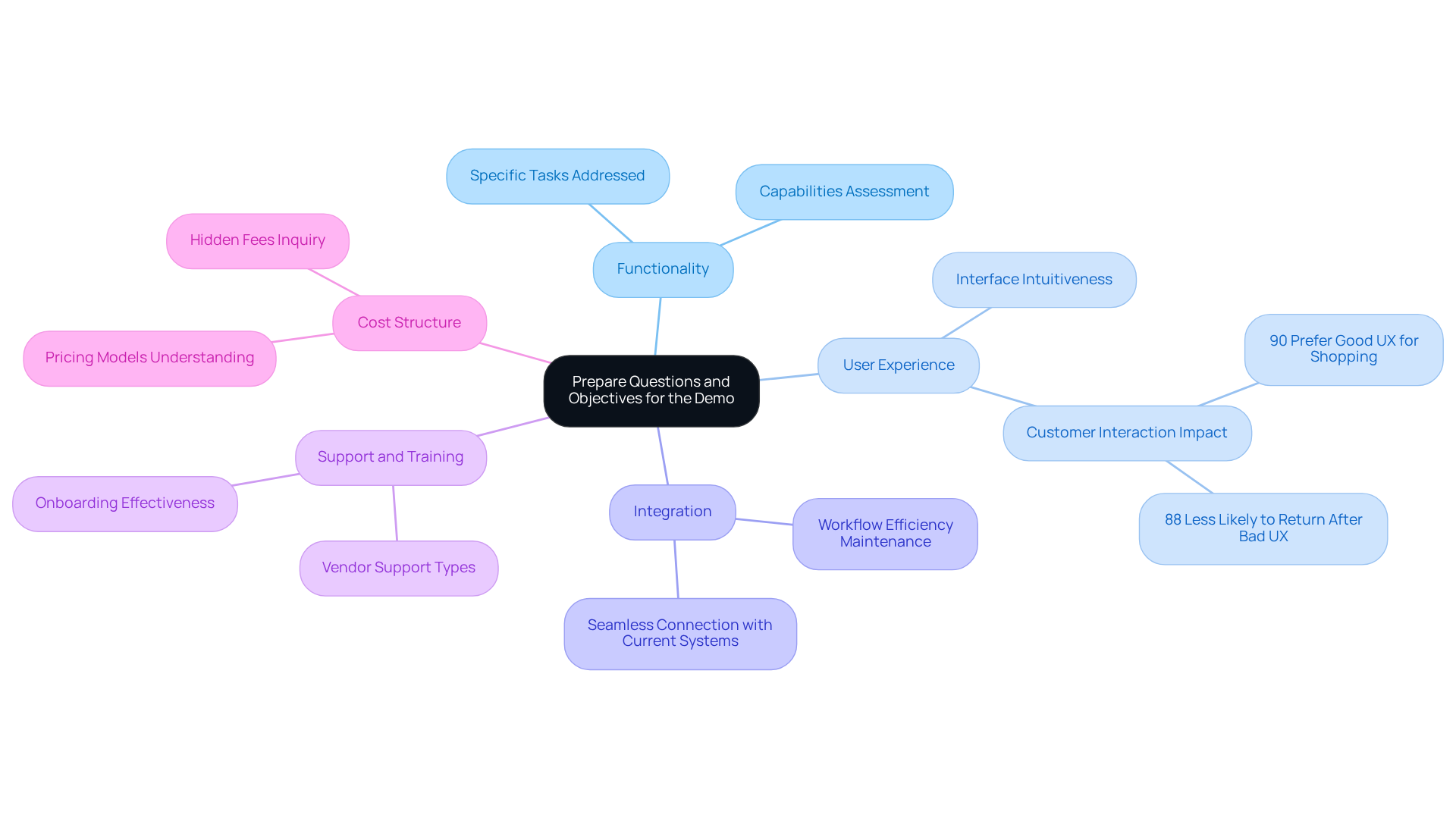
Evaluate the Demo and Make Your Decision
Following the presentation, it is essential to meticulously assess the application against your prepared inquiries and goals. To ensure a comprehensive evaluation, follow these steps:
- Gather Feedback: Engage with your team members who attended the demo to collect their impressions and insights. This collaborative approach can uncover diverse perspectives that may influence your decision. As Gallup notes, employees who receive meaningful feedback are four times more likely to be engaged, underscoring the importance of team input in the decision-making process.
- Score Each Feature: Implement a scoring system (e.g., 1-5) to rate the application based on how effectively it meets your specific needs. This quantitative assessment aids in comparing different options objectively. Consider utilizing common scoring metrics from the real estate industry to ensure relevance.
- Consider Long-term Value: Look beyond short-term advantages and assess the long-term effects of implementing the system. Companies with continuous performance management report significant improvements in effectiveness and retention, emphasizing the necessity to consider scalability, support, and integration with existing systems for sustainable value.
- Follow Up with Vendors: If lingering questions remain or clarifications are required, do not hesitate to reach out to the vendors. This dialogue can provide deeper insights into the system's capabilities and support.
Finally, compile your scores and feedback to compare your top choices. Make a decision based on which software aligns best with your operational needs and offers the most compelling value for your organization.
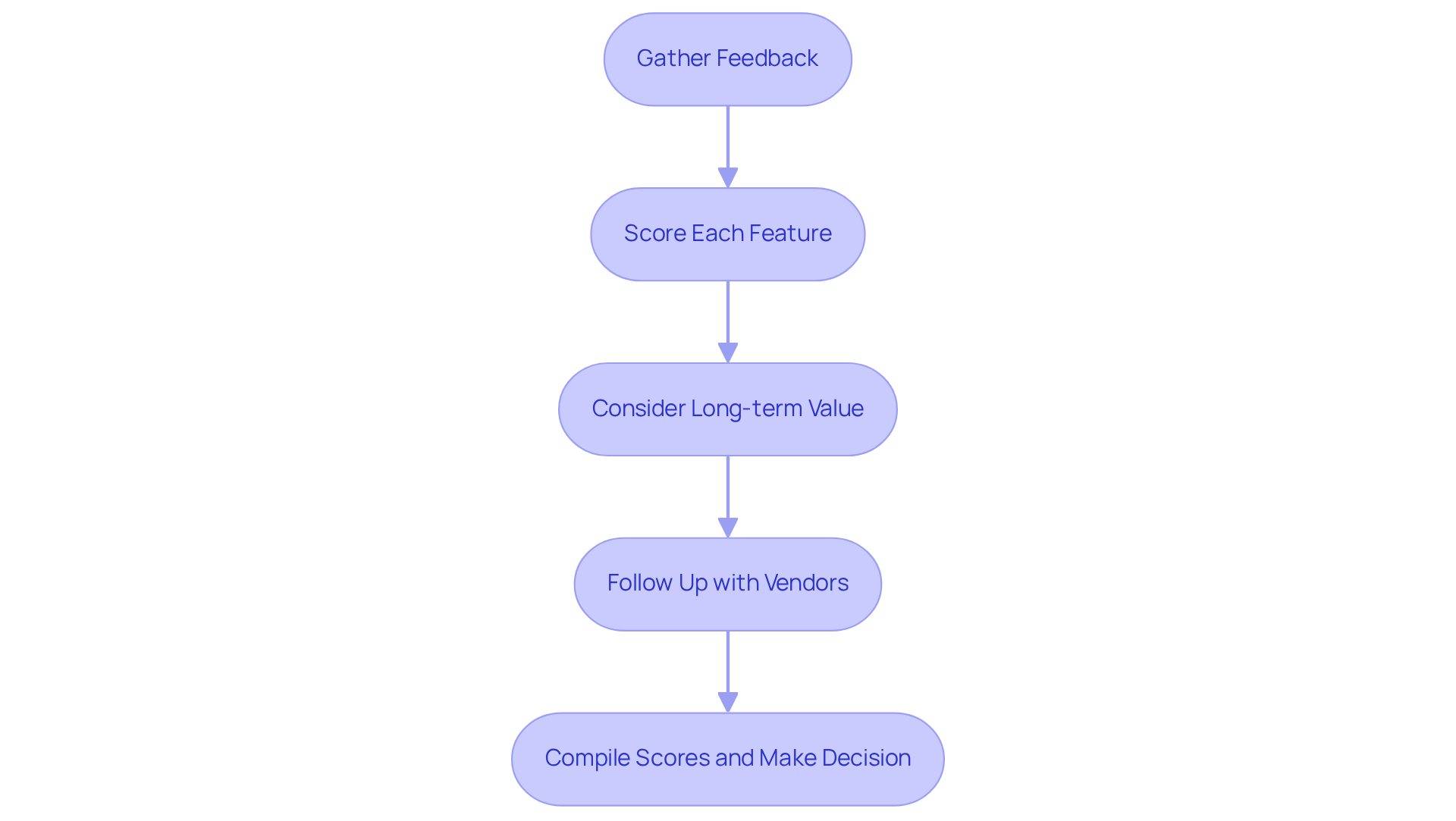
Conclusion
Identifying and booking a demo for digital land record software is a pivotal step in enhancing property record management. This process not only streamlines operations but also ensures that organizations select a solution tailored to their specific needs. By following the outlined steps, stakeholders can make informed decisions that align with their operational goals and improve overall efficiency.
Key arguments throughout the article underscore the necessity of thoroughly assessing individual software needs, conducting extensive research on available options, and preparing effectively for vendor demos. Engaging with team members and evaluating software features against established criteria further supports a collaborative and informed decision-making process. Each stage—from identifying needs to evaluating the demo—plays a vital role in achieving a successful software selection.
Ultimately, investing time and effort into this process can yield significant long-term benefits for property management organizations. By prioritizing thorough evaluations and informed choices, stakeholders can enhance their operational integrity and efficiency in managing land records. Taking these steps not only improves current practices but also positions organizations for future success in an increasingly digital landscape.
Frequently Asked Questions
What should I consider when identifying my digital land record software needs?
When identifying your digital land record software needs, consider the volume of records you manage, the types of records you encounter (such as deeds, leases, and surveys), integration requirements with existing systems, and the specific needs of the end-users who will utilize the application.
Why is it important to assess my current property record management procedures?
Assessing your current property record management procedures helps identify specific challenges and requirements, which is crucial for selecting the most suitable digital record management solution.
What methods can I use to research available digital land record software options?
You can research available digital land record software options by checking online reviews on platforms like Capterra or G2, visiting vendor websites for detailed information, engaging in industry forums or social media groups, and seeking peer recommendations from colleagues or industry contacts.
How can online reviews help in selecting digital land record software?
Online reviews provide insights into application performance and user satisfaction, helping you gauge the reliability and effectiveness of different software options.
What features should I consider when creating a list of potential software options?
When creating a list of potential software options, consider current trends in digital record software features such as automated data validation, user-friendly interfaces, and the ability to handle extensive property data accurately.
Can you provide an example of a software option for land management?
An example of a software option for land management is RealEstateAPI, which offers access to financial and physical details of 159 million properties, emphasizing the importance of accurate data in land management.




